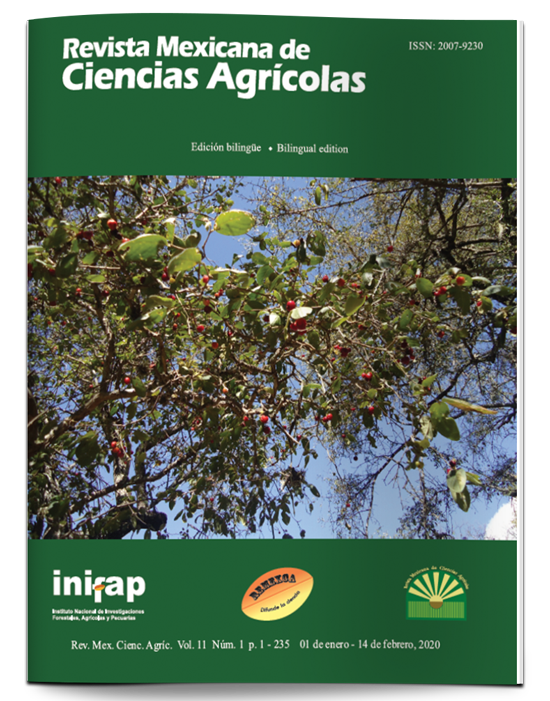Thermotolerance in sorghum lines [Sorghum bicolor (L.) Moench] for grain
DOI:
https://doi.org/10.29312/remexca.v11i1.1945Keywords:
Sorghum bicolor (L.) Moench., cell membrane damage, heat tolerance, water stressAbstract
Extreme weather, such as increased drought and high temperatures, has had a significant impact on crop yields. Therefore, it is important to identify characters in sorghum genotypes that help them lessen the impact of these factors and allow them to be productive. The objective of this work was to evaluate the heat tolerance of a group of granite sorghum B and R lines under two humidity conditions to select the best heat tolerant lines. 28 experimental lines B and R were planted on August 30, 2017 in Marin, NL, Mexico. The experiment was sown in a completely randomized design with an arrangement in divided plots and with two repetitions the moisture treatment under water stress was applied 43 days after sowing (DDS) for a period of four weeks without irrigation. Data were taken from days to flowering, damage to the cell membrane at 40 °C and relative leaf water content (CRA). The results showed that the CRA did not allow to establish differences between genotypes, while the heat treatment applied at 40 °C, allowed to establish differences and classify them according to the percentage of damage caused to the cell membrane, since this is one of the features widely used to select tolerant genotypes. Genotypes 20 and 22 were identified as heat tolerant and genotypes 5 and 8 were susceptible.
Downloads
Published
How to Cite
Issue
Section
License
The authors who publish in Revista Mexicana de Ciencias Agrícolas accept the following conditions:
In accordance with copyright laws, Revista Mexicana de Ciencias Agrícolas recognizes and respects the authors’ moral right and ownership of property rights which will be transferred to the journal for dissemination in open access. Invariably, all the authors have to sign a letter of transfer of property rights and of originality of the article to Instituto Nacional de Investigaciones Forestales, Agrícolas y Pecuarias (INIFAP) [National Institute of Forestry, Agricultural and Livestock Research]. The author(s) must pay a fee for the reception of articles before proceeding to editorial review.
All the texts published by Revista Mexicana de Ciencias Agrícolas —with no exception— are distributed under a Creative Commons License Attribution-NonCommercial 4.0 International (CC BY-NC 4.0), which allows third parties to use the publication as long as the work’s authorship and its first publication in this journal are mentioned.
The author(s) can enter into independent and additional contractual agreements for the nonexclusive distribution of the version of the article published in Revista Mexicana de Ciencias Agrícolas (for example include it into an institutional repository or publish it in a book) as long as it is clearly and explicitly indicated that the work was published for the first time in Revista Mexicana de Ciencias Agrícolas.
For all the above, the authors shall send the Letter-transfer of Property Rights for the first publication duly filled in and signed by the author(s). This form must be sent as a PDF file to: revista_atm@yahoo.com.mx; cienciasagricola@inifap.gob.mx; remexca2017@gmail.
This work is licensed under a Creative Commons Attribution-Noncommercial 4.0 International license.



